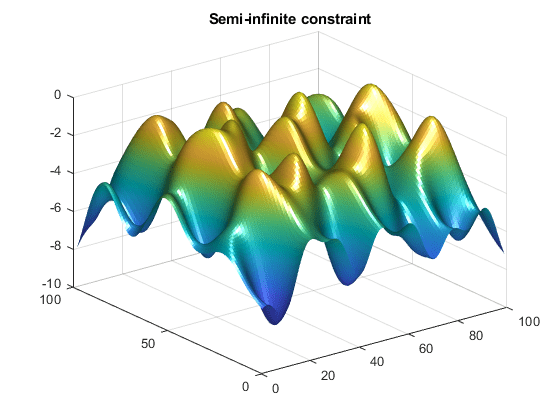二维半无限约束
找到最小化 x 的值
f(x) = (x1 – 0.2)2 + (x2– 0.2)2 + (x3– 0.2)2,
其中
对于范围内的所有 w1 和 w2 值
1 ≤ w1 ≤ 100,
1 ≤ w2 ≤ 100,
初始点为 x = [0.25,0.25,0.25]。
注意半无限约束是二维的,即矩阵。
首先,编写一个计算目标函数的文件。
function f = myfun(x,s) % Objective function f = sum((x-0.2).^2);
其次,为约束编写一个文件,名为 mycon.m。每次调用 mycon 时,包含绘制半无限约束的表面图的代码。这样您就可以看到在最小化 X 时约束如何变化。
function [c,ceq,K1,s] = mycon(X,s) % Initial sampling interval if isnan(s(1,1)), s = [2 2]; end % Sampling set w1x = 1:s(1,1):100; w1y = 1:s(1,2):100; [wx,wy] = meshgrid(w1x,w1y); % Semi-infinite constraint K1 = sin(wx*X(1)).*cos(wx*X(2))-1/1000*(wx-50).^2 -... sin(wx*X(3))-X(3)+sin(wy*X(2)).*cos(wx*X(1))-... 1/1000*(wy-50).^2-sin(wy*X(3))-X(3)-1.5; % No finite nonlinear constraints c = []; ceq=[]; % Mesh plot m = surf(wx,wy,K1,'edgecolor','none','facecolor','interp'); camlight headlight title('Semi-infinite constraint') drawnow
接下来,调用优化程序。
x0 = [0.25, 0.25, 0.25]; % Starting guess
[x,fval] = fseminf(@myfun,x0,1,@mycon)经过九次迭代后,解是
x
x =
0.2523 0.1715 0.1938解处的函数值为
fval
fval =
0.0036目标是最小化目标 f(x),使得半无限约束满足 K1(x,w) ≤ 1.5。在解 mycon 处评估 x 并查看矩阵 K1 的最大元素表明该约束很容易满足。
[c,ceq,K1] = mycon(x,[0.5,0.5]); % Sampling interval 0.5
max(max(K1))ans = -0.0370
对 mycon 的调用产生了以下冲浪图,该图显示了 x 处的半无限约束。
